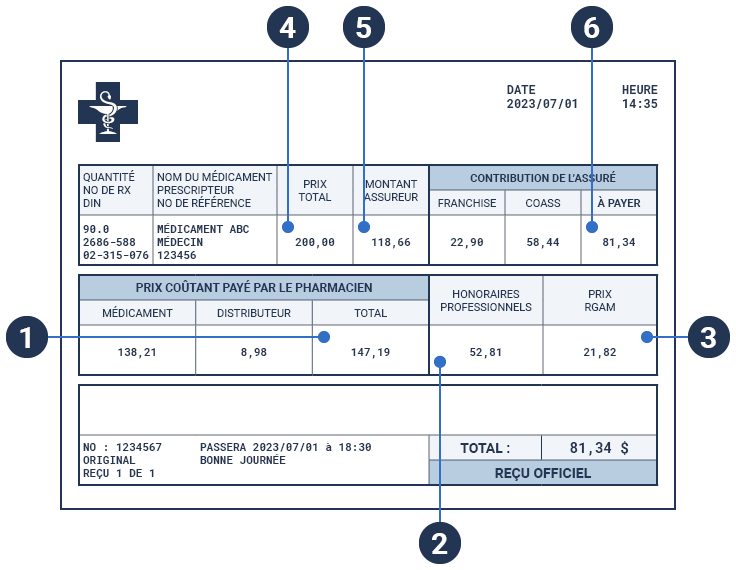Understand my pharmacy invoice
Deductible, co-insurance, maximum contribution… Your prescription drug invoice may be complex, and the amount you pay may vary over the month. Find out how to demystify your pharmacy invoice.
Your invoice explained
When you purchase drugs covered under the public plan, a portion of the amount is paid by RAMQ and the other by you. The amount you pay includes the deductible and your part of the co-insurance. Each month, if you reach your maximum contribution, you can obtain other covered drugs free of charge until the end of the month.
To find out more about cost distribution and your monthly contribution, refer to the Amount to pay for prescription drugs webpage.

The cost price paid by the pharmacist excludes their profit margin and includes 2 elements
- Price of the prescription drug: actual price paid by the pharmacist for a prescription drug
- Amount paid to the distributor: amount set by the government and paid by the pharmacist for the supply of prescription drugs
Professional fees include the direct and indirect expenses associated with the pharmacist’s professional service and the maintenance of the pharmacy’s operations, as well as the profit margin.
This is the amount covered by the basic prescription drug insurance plan. Your insurer (RAMQ or private insurer) is required to cover it.
The total price is obtained by adding the cost price paid by the pharmacist and the professional fees. Certain pharmacies indicate Montant Rx on their invoice instead of Prix total.
This is the amount paid by your insurer: RAMQ or benefit plan. It must at least cover the price of the basic prescription drug insurance plan.
The contribution by the insured person is the amount you have to pay, which is the sum of the deductible and the co-insurance.
- Deductible: amount you pay through your first purchases of the month
- Co-insurance: amount not covered by your insurer that you have to pay
- To be paid: amount that combined the deductible and co-insurance
How much do your prescription drugs cost?
How much do your prescription drugs cost?
When you purchase prescription drugs covered by the public plan, you usually pay part of the cost.
How is the payment distributed between you and RAMQ? Here is an example!
Suppose that your first prescription of the month is $200.
The cost of the prescription is the total of the cost price paid by the pharmacist and their professional fee. This total is indicated in the "Prix total" field on your invoice.
Of this total, you first pay $22.90. This is the deductible, a fixed monthly amount that you pay on your first purchases of the month.
There is $177.10 left to pay, with the following distribution: you pay 33%, RAMQ pays 67%.
Your contribution when you purchase your prescription drugs is therefore the deductible and the remaining 33% of the amount.
Regardless of the cost of your prescription, you will never pay more than $99.65. This is your maximum monthly contribution.
The following month, you will pay the deductible again on your first purchases and then your 33% contribution.
Any questions? Go to our website at ramq.gouv.qc.ca.
Frequently asked questions
Putting pills in a pillbox is not a service covered unless clinically justified (cognitive impairment, for example).
Each time you purchase covered drugs, you pay a portion of the monthly contribution. If you reach the maximum contribution amount before the end of the month, you can usually obtain other covered drugs free of charge until the end of the month.
The maximum contribution amounts may vary depending on your situation. They are adjusted on July 1 each year. If the cost of your drugs changes, the point at which you reach your maximum contribution may also change.
If you buy several prescription drugs each month, the deductible is applied to the first drugs listed on the invoice. Therefore, if they are entered in a different order from the previous month, the amount paid for the same drug may vary. At the end of the month, you can check that your deductible has not exceeded $22.90.
If you purchase prescription drugs for more than a month, you must pay the deductible for each of those months as if you were purchasing it on the expected renewal date.
The introduction of a new generic drug may also change your invoice amount. Find out more about generic drug coverage on the Know the conditions for coverage webpage.
Other factors
Other factors may affect the amount you have to pay for your prescription drugs, including:
- Change of insurer (your coverage may differ from one insurer to another)
- Increase or decrease in your income
- Change in your employment status
- Change in your family situation, for example, new couple, child no longer considered a dependant)
- Annual indexation of the maximum contribution (July 1)
Yes, but you must pay the deductible and co-insurance as if you were purchasing your prescription drug on the expected renewal date.
